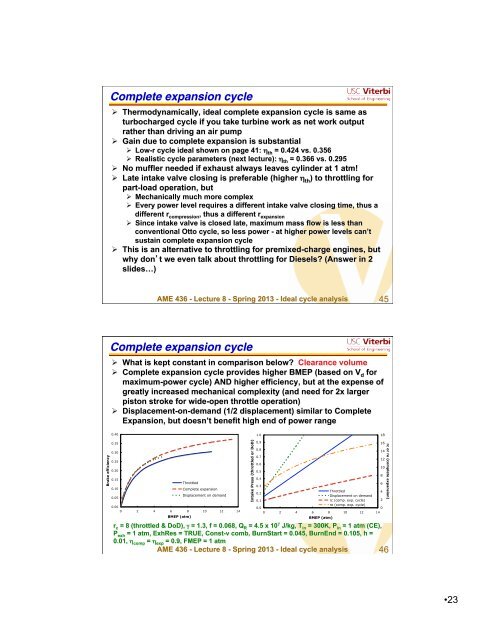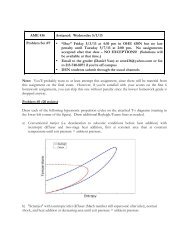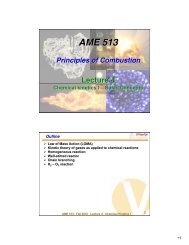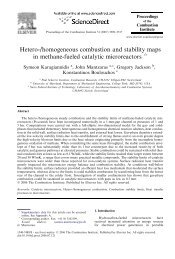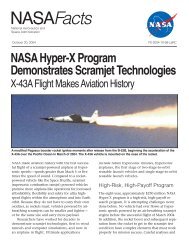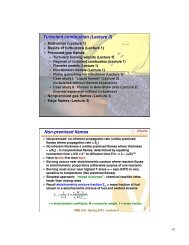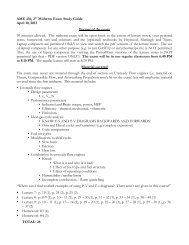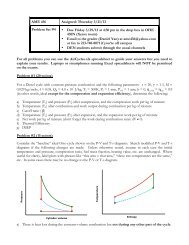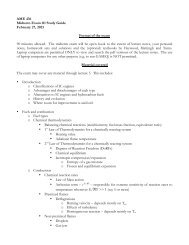AME 436
AME 436
AME 436
You also want an ePaper? Increase the reach of your titles
YUMPU automatically turns print PDFs into web optimized ePapers that Google loves.
Complete expansion cycle"<br />
Thermodynamically, ideal complete expansion cycle is same as<br />
turbocharged cycle if you take turbine work as net work output<br />
rather than driving an air pump<br />
Gain due to complete expansion is substantial<br />
Low-r cycle ideal shown on page 41: η th = 0.424 vs. 0.356<br />
Realistic cycle parameters (next lecture): η th = 0.366 vs. 0.295<br />
No muffler needed if exhaust always leaves cylinder at 1 atm!<br />
Late intake valve closing is preferable (higher η th ) to throttling for<br />
part-load operation, but<br />
Mechanically much more complex<br />
Every power level requires a different intake valve closing time, thus a<br />
different r compression , thus a different r expansion<br />
Since intake valve is closed late, maximum mass flow is less than<br />
conventional Otto cycle, so less power - at higher power levels can’t<br />
sustain complete expansion cycle<br />
This is an alternative to throttling for premixed-charge engines, but<br />
why dont we even talk about throttling for Diesels (Answer in 2<br />
slides…)<br />
<strong>AME</strong> <strong>436</strong> - Lecture 8 - Spring 2013 - Ideal cycle analysis<br />
45<br />
Complete expansion cycle"<br />
What is kept constant in comparison below Clearance volume<br />
Complete expansion cycle provides higher BMEP (based on V d for<br />
maximum-power cycle) AND higher efficiency, but at the expense of<br />
greatly increased mechanical complexity (and need for 2x larger<br />
piston stroke for wide-open throttle operation)<br />
Displacement-on-demand (1/2 displacement) similar to Complete<br />
Expansion, but doesn’t benefit high end of power range<br />
0.40<br />
1.0<br />
18<br />
Brake efficiency<br />
0.35<br />
0.30<br />
0.25<br />
0.20<br />
0.15<br />
0.10<br />
0.05<br />
0.00<br />
Throttled<br />
0 2 4 6 8 10 12 14<br />
BMEP (atm)<br />
Complete expansion<br />
Displacement on demand<br />
Intake Press (throttled or DoD)<br />
r c = 8 (throttled & DoD), γ = 1.3, f = 0.068, Q R = 4.5 x 10 7 J/kg, T in = 300K, P in = 1 atm (CE),<br />
P exh = 1 atm, ExhRes = TRUE, Const-v comb, BurnStart = 0.045, BurnEnd = 0.105, h =<br />
0.01, η comp = η exp = 0.9, FMEP = 1 atm<br />
<strong>AME</strong> <strong>436</strong> - Lecture 8 - Spring 2013 - Ideal cycle analysis 46<br />
0.9<br />
0.8<br />
0.7<br />
0.6<br />
0.5<br />
0.4<br />
0.3<br />
0.2<br />
0.1<br />
0.0<br />
0 2 4 6 8 10 12 14<br />
BMEP (atm)<br />
Throttled<br />
Displacement on demand<br />
rc (comp. exp. cycle)<br />
re (comp. exp. cycle)<br />
16<br />
14<br />
12<br />
10<br />
8<br />
6<br />
4<br />
2<br />
0<br />
rc or re (complete expansion)<br />
• 23


